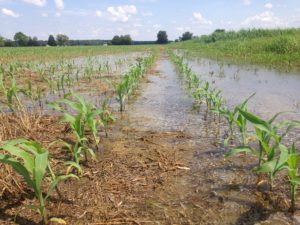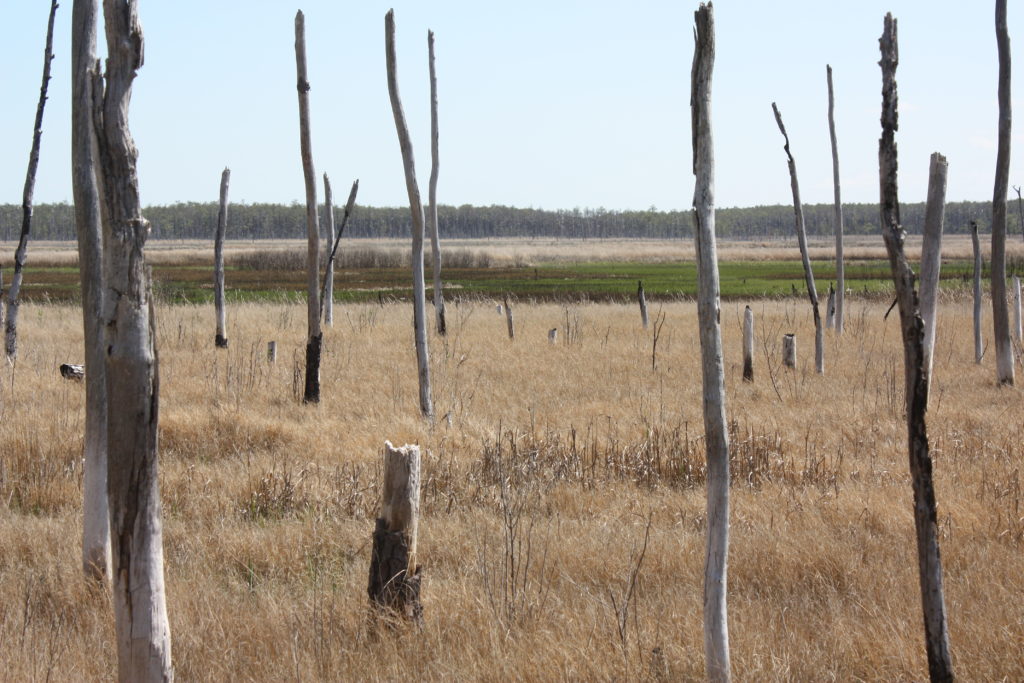by Quinn Burkhart
Most people need to visit the ocean to get their sea water fix. But beneath their feet, those waters may already be closer than they think. “Saltwater intrusion,” which occurs when the sea level rises and pushes large amounts of saltwater onto the coast, is one of the most prominent—and least talked about—effects of climate change. Its influence on the Chesapeake Bay, one of the lowest regions in the United States, is gaining traction.
As the planet heats up, ice melts and warming water expands, leading to saltwater flooding on the coast. This causes problems for plants and animals that aren’t used to living in salty environments. It also makes it more likely that species which thrive in saltwater will begin growing upstream and upset habitats.

Corn fields in the coastal South of the U.S. are continuously hurt by saltwater flooding. Photo: Dr. Katherine Tully, University of Maryland
“Unfortunately, because of how quickly the sea levels are already rising, it’s impossible for affected plants and animals in these areas to adapt to the saltwater,” said Tom Jordan, a senior scientist at the Smithsonian Environmental Research Center who recently co-authored a report on the problem. “What we can do is modify our own practices in helping their growth.”
Initial climate change evidence has seemingly led us to believe that only coastal areas will be shocked by saltwater flooding. But the contents of your shopping cart could soon feel the jolt. American agriculture is especially vulnerable to saltwater intrusion from storm surges and irrigation systems, to the point where farmers consider abandoning old fields where it’s impossible to grow healthy crops. In a growing number of places, “business-as-usual” farming is off the menu.
The Onset of Invasion
Agriculture is already undergoing a sea change. Temperatures and precipitation levels are constantly hitting new extremes of high and low, warm and cold. If farmers can’t correctly predict the changing seasons, they may plant too early or too late. The same goes for harvests. Saltwater intrusion only adds to the existing frustration. As the elevation gap closes between salt and fresh water terrains, we’ll begin seeing more repercussions of two very different waters mixing.
Rising saltwater can also bring invasive species. Some species, like the salt cedar tree, prefer moderate salinity, while others enjoy significantly saltier water. When the saltwater levels in the estuary and rivers rise, these species begin growing farther upstream as they chase their environments.
Invasive species take over the area that regular crops normally occupy, growing so quickly that they overshadow and kill the field’s harvest. Classic field crops, like corn and wheat, have little salt tolerance and die in places where the salinity is high, expanding the ability for invasive species to grow.
Some of this happens in plain sight, where farmers can see the plants that have died and understand the consequences. Other saltwater flooding damage happens below the surface, where scientists have to investigate.
Jordan’s research focuses on how saltwater intrusion will affect the soil’s phosphorus cycle. Phosphorus is a chemical that helps keep plants growing. Although a natural part of the soil cycle, too much phosphorus can be dangerous because it can boost weed growth.
Soil that has been used for multiple generations of farming has become richly fertilized. Saltwater flooding can cause too much phosphorus to cultivate in the soil, which then depletes the oxygen level for plants. Jordan’s research focuses on the Bay, a location on the edge of the worst climate change effects. But variations in the phosphorus cycle may continue anywhere the water’s saltiness is rising.
Stemming the Tide
We have options to fix this issue. According to Jordan, a few possibilities include building tide gates, modifying plants for salt marsh communities, and bulldozing farmland to create uniformly high ground. But time may not be on our side.
“We are only learning how to do these processes now,” Jordan said. “We will require time to adapt to these changes, just like these species.”
Irrigation systems and canals, once built to move freshwater to thirsty farmland, now exacerbate the problem by pushing saltwater into lower agricultural areas. Many farmers use tide gates, which are designed to drain tidelands in an effort to prevent low-lying ground from flooding. Other farmers switch over to plants that can tolerate saltier water, like tomatoes and rice. Some simply abandon their fields when the salinity grows too high. Although this strategy can allow the entire field to adapt to the differing water content, it often merely leaves the land wide open to invasive species.
Keeping a positive outlook is valuable, but action is imperative. For Jordan, saltwater intrusion is a consequence all of us should be vigorously seeking to reverse. “We will not be able to fix this in one or two generations,” he said, “our problem is that we may no longer have land to protect in three generations.”


